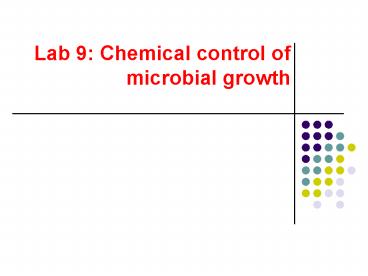Lab 9: Chemical control of microbial growth - PowerPoint PPT Presentation
1 / 12
Title:
Lab 9: Chemical control of microbial growth
Description:
Alcohol: lab bench, hospital. This is more effective if mixed with water (70% more effective than 95 ... So the disks adsorb to the agar. invert. Incubate at 37 C. ... – PowerPoint PPT presentation
Number of Views:143
Avg rating:3.0/5.0
Title: Lab 9: Chemical control of microbial growth
1
Lab 9 Chemical control of microbial growth
2
Disinfectant
- Chemical used on surfaces of inanimate object to
kill microbes - Chlorine swimming pool
- Chloramine drinking water
- Alcohol lab bench, hospital. This is more
effective if mixed with water (70 more effective
than 95) - Ozone, potassium permanganate, quaternary
ammonium, sodium hypochlorite (bleach)
3
Antiseptics
- Chemical used on living tissues to kill microbes
- Alcohol
- Iodine
- Hydrogen peroxide
- Some disinfectants are also antiseptics
- In surgery prefer to use aseptic (sterile)
techniques instead of antiseptics
4
Antibiotics
- Drugs that kill or inhibit the growth of some
bacteria - Bactericide (kill)
- Bacteriostatic (Inhibit growth)
- Target microbes with minimal side effects to the
host - Will also kill friendly host bacteria (such as
the ones in digestive tract)
5
Antibiotic
- Produced by mold
- Produced by other bacteria
- Can also be produced in laboratory
chemotherapeutic agent ? purely synthetic
6
Objective 1 Effectiveness of Antibiotics
(Individual) Disk-diffusion technique
- Swab the entire surface of 1 MH (Mueller-Hinton)
plate with 1 bacterial culture
- Staphylococcus aureus, Pseudomonas aeruginosa,
Bacillus subtilis, or Escherichia coli Place 3
paper disks containing antibiotics onto the MH
plate. you use 3 different antibiotic per plate,
3 disk total per plate - Let the plate dry for a 5 minutes. So the disks
adsorb to the agar. ? invert - Incubate at 37C.
7
Objective Effectiveness of Antibiotics
http//www.srga.org/BILDER/Inok2.gif
8
Forcep sterilization
- Put into alcohol
- Flame ? let cool
- Use
- Put back into alcohol
- Flame
- ? your done
- Do not put hot forceps into the alcohol
9
Zone of inhibition
- resistant
intermediate
susceptible
http//dept.kent.edu/microbiology/htm/resist.jpg
http//www.bspp.org.uk/bsppnews/bsppnews38/byron.j
pg
10
Zone of inhibition (mm)
11
Objective 2 II. Effectiveness of Antiseptics
Disinfectants
- Using sterile forceps place 1 sterile paper disks
into plates containing antiseptics/ desinfectants - Repeat this step using other antiseptics/
desinfectants - Using a cotton swab on 1 TSA plate, make a lawn
with 1 of the four organisms - Bacillus subtilis,
- Staphylococcus aureus,
- Pseudomonas aeruginosa or
- Escherichia coli
- Using a sterile forceps place the 3 disk made
during step 1 onto the plate. - You may lightly press the disk into the agar. Be
careful to not press the disk below the agar
surface. - Label the plate and incubate it in the inverted
position at 37C until the next lab period
12
Objective 3. Effectiveness of washing hands
- 1 TSA plate divided into fourth
- In each section touch after a hand washing action
- quadrant 1 dry touch prior to any hand washing
- quadrant 2. wet touch after washing hands with
only water - quadrant 3. wet touch after washing hands with
soap and water - quadrant 4. dry touch after washing hands with
soap and water again - Let plate dry before turning it upside down
- Incubate at 37































